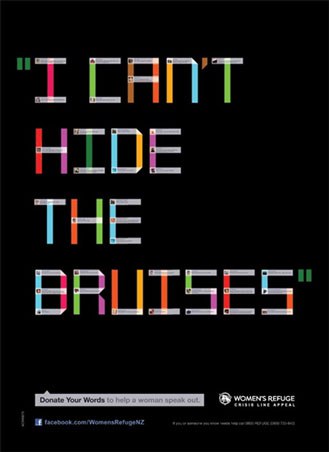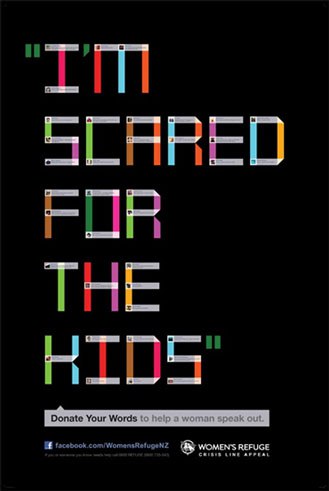Lean on Me
Our thanks: The National Collective of Independent Women's Refuges Incorporated is not a public entity – the organisation willingly participated in our work so we could share what it learned.
 In 2010, the Police recorded more than half of all murders as related to family violence, a proportion that had remained roughly static since 2006. Family-related violence against women remains a significant issue in New Zealand.
In 2010, the Police recorded more than half of all murders as related to family violence, a proportion that had remained roughly static since 2006. Family-related violence against women remains a significant issue in New Zealand.
[It was] vital to engage with a younger generation of supporters and potential service users.
Women’s refuges provide advice, support, and a safe haven for women. The first women’s refuge in New Zealand was set up in 1973 by a group of Christchurch women. There are now 45 local women's refuges structured under one umbrella organisation, the National Collective of Independent Women's Refuges Incorporated (Women’s Refuge). Its vision is “leadership that influences the prevention and elimination of domestic violence”.
Women’s Refuge is New Zealand's largest not-for-profit charitable organisation dedicated to preventing domestic violence. It relies heavily on government funding; in 2012, core funding from the Ministry for Social Development was $6.6 million, representing about 75% of the total income for Women’s Refuge.
That core funding has been reducing in cash terms since 2009, and Women’s Refuge has been trying to offset this by increased fundraising. At the same time, demographic changes are affecting Women’s Refuge. Its donor base is ageing but nearly 60% of its service users are 35 years of age or younger.
What was the project’s aim?
Women’s Refuge has used social media to help ensure that its financial support is sustainable and to remain visible to potential service users. Women’s Refuge needs to attract younger donors and promote its services in ways that are better suited to younger women who might need its services. The co-chairs of Women’s Refuge have stated that they see it as vital to engage with a younger generation of supporters and potential service users. They felt that social media would be an effective form of communication to target a younger audience.
Campaigning is an important part of Women’s Refuge’s activities because it helps to meet multiple objectives:
- educating people about domestic violence;
- promoting its services to anyone who needs them; and
- increasing fundraising.
Doing things differently
“Donate your Words” encouraged people to use words to help a woman in need to speak out.
Part of Women’s Refuge’s campaigning is a national annual appeal. It works closely with an external communications agency, which donates its time as part of a corporate citizenship programme.
The 2011 campaign
In 2011, Women’s Refuge decided to move from its usual week-long television advertising campaign to a month-long social media campaign. It used Trade Me’s “Message board” to tell harrowing stories of those affected by domestic violence and to raise funds. It was also an experimental "toe in the water" approach to using social media.
An “Auction like no other” on Trade Me was intended to stimulate lots of online conversation, Facebook "likes", and Twitter followers, and inspire people to bid on celebrity auctions or donate to the annual appeal. Women’s Refuge chose Trade Me because it is accessible and popular, and was considered a good way to spread the word about Women’s Refuge’s work and services.
Intriguing and provocative messages were designed to lead people to the Trade Me auction, which was fronted by domestic violence victims and their families. In the messages, each person symbolically provided a personal item for auction that was close to their or the victim's heart. Although the items were not for sale, they acted as a donation portal for Trade Me users, with “bidders” automatically making a $25 donation and receiving a personalised thank you for pledging their support.
Social media was where the campaign provoked the most discussion and support.
Although Women’s Refuge regarded the campaign as a success, it did have some drawbacks. There were some technical issues that took time to work through, and dealing with the number of bids and donations became labour intensive.
The 2012 campaign
After reflecting on the 2011 campaign, Women’s Refuge concluded that the 2012 campaign needed to reach the same target audience, but in a less labour-intensive way.
In 2012, Women’s Refuge continued using social media to augment its usual street collections and advertising. It used a Facebook campaign centred on a free Facebook application, with support from other communications channels, such as radio and television.

The “Donate your Words” application on Facebook encouraged people to use words to help a woman in need to speak out. It directed people to a short promotional video and then encouraged them to update their Facebook status. The size of their donation was based on the number of words they used to update their status. An acknowledgement was posted on the donator’s timeline, publicly recognising the donation and further promoting the campaign.
The campaign received some coverage in the mainstream media, but Women’s Refuge reported that social media was where the campaign provoked the most discussion and support. Women’s Refuge believes that it might have been the first organisation in New Zealand to use a Facebook application in this way.
The campaign was supported by a community of Twitter users who shared links to the Women’s Refuge’s website and the “Donate your words” application. Some high-profile New Zealand personalities Tweeted to their more than 10,000 followers. The “Donate your words” application and Women’s Refuge’s campaign were popular Twitter topics during the campaign period.
Was it a success?
More than 55,000 Facebook users saw the Refuge’s campaign appear on their own pages.
In the view of Women’s Refuge, the campaign generated an excellent response and succeeded in introducing the Refuge’s work to a younger audience.
The “Donate your words” application reached about 5,000 visitors and Women's Refuge's Facebook “likes” increased by about 40%. During the campaign, Facebook’s analysis reported almost a doubling of people “talking about” (which is one of the ways that Facebook measures activity) Women’s Refuge’s social media content.
During July 2012, more than 55,000 Facebook users saw the Refuge’s campaign appear on their own pages. At the very least, this helped raise awareness of Women’s Refuge and the 24/7 crisis line. The crisis line, staffed largely by unpaid volunteers, receives around 86,000 calls every year – that’s an average of one call every six minutes.
The campaign’s conversion rate was double what is considered by the industry to be a success.The “Donate your words” application was very popular but donating money through social media is a relatively new concept – donors were hesitant about donating through Facebook. This reinforces the idea that Women’s Refuge needs to move and progress at a pace its target audience is comfortable with.
In a difficult economic environment, the campaign highlights included:
- donations in the first week for 2012 being double that of the first week in 2011;
- the 2011 and 2012 campaigns each raised around $140,000, an increase of 10%-15% on earlier campaigns that had not used social media; and
- a 25% increase in women emailing Women’s Refuge’s helpline.
The Facebook users who were “liking”, sharing, and commenting on the Refuge’s posts were predominantly young and female. The highest engagement online was among women aged 18-35, a group that Women’s Refuge believes contain the donors, refuge workers, and service users of the future.
Women’s Refuge has decided to simplify and continue with the Facebook application for its 2013 campaign.
What did Women’s Refuge learn?
Women’s Refuge analysed the experience of using social media and identified some lessons. Those lessons include knowing your audience and targeting them using social media alongside using other forms of media. A big lesson for Women’s Refuge lay in realistically estimating the resources needed to support its social media campaign.
Lessons Women’s Refuge learned from using social media for raising funds and raising awareness
| Lessons |
|
|---|
